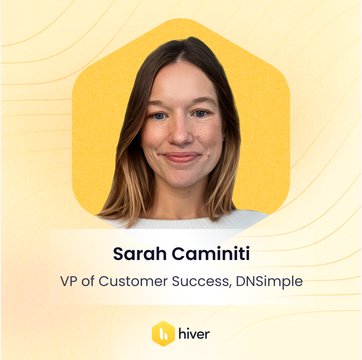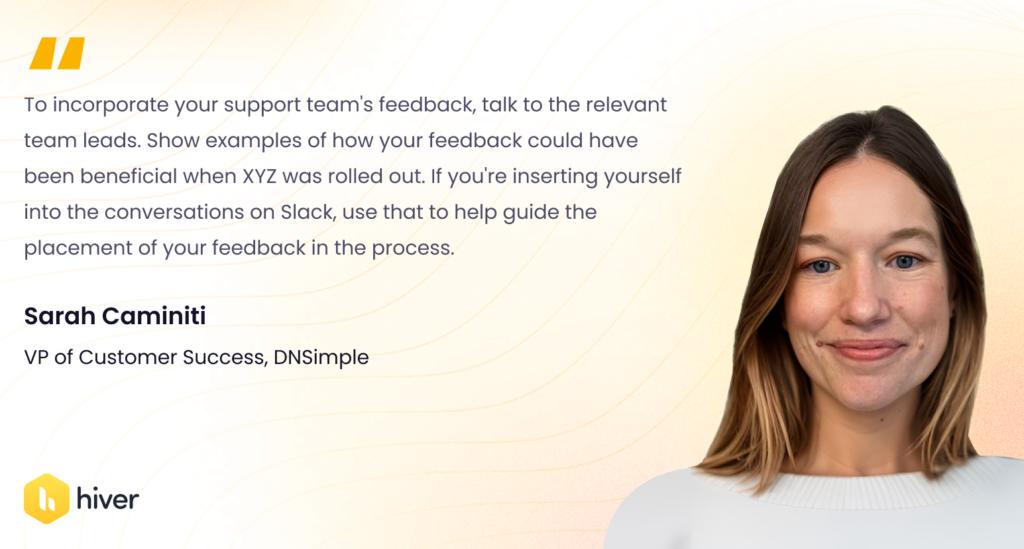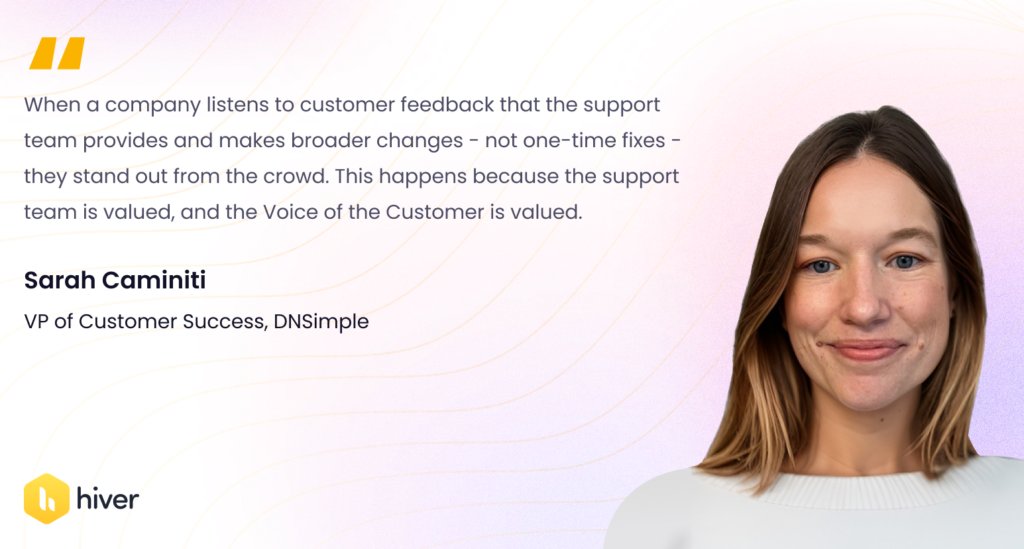Why Customer Support Needs a Seat at the Table

Table of contents
Customer support has long been treated like a silo or an isolated function. It’s been there to primarily solve and fix issues – AFTER they happen.
Support is there to react to things, and by doing this, businesses are playing catch up with their customers.
If you want to be a step ahead of your customers and proactively fulfill their needs, you need to change the way you think about support.
What does this entail?
I recently had a chat with Sarah Caminiti, the Vice President of Customer Success at DNSimple, about this subject.
With more than fifteen years of experience in customer advocacy, particularly in the SaaS industry, Sarah spoke about:
- Why customer support needs a seat at the decision-making table.
- The importance of a feedback loop between customer support and product teams.
- Initiatives that have made the Voice of Customer more prominent in her organization.
Q1. In your experience, how has feedback from customer support teams directly influenced product improvements or innovations?
I’ve been in support for a long time, in varying roles and in so many different fields. One of my biggest areas of frustration has always been that support was rarely included when product improvements or innovation decisions were being made.
Why are support professionals not the first people invited to the table when they are the only ones actually connecting with the customers on a regular basis?
I couldn’t answer that question, but I knew I couldn’t just wait for something to change. So I started collecting data and sharing it with everyone in the company to bring the customer directly to them.
Even still, I learned that you can share everything you discover and wave your arms as high as you can, but change and involvement will not be guaranteed unless it’s part of the Standard Operating Procedure.
Until that happens, what’s worked the most for me has been:
- Making a newsletter. I focus on trends, share example conversations and send it to the entire company. Once this was implemented, developers took the initiative to tackle issues that were highlighted and departments were able to have the data to look at situations from another angle.
- Celebrating the wins. I make it a point to bring up support successes and positive feedback as much, if not more, than the frustrations. A lot of good comes out of these support interactions, and I want that to be felt as often. The newsletter is a great place to do this and see the wins in one place. Slack is another perfect spot to cheer and give kudos.
- Track trends, and not just topics. This paints a much clearTrack trends, and not just topics. This paints a much clearer picture of what is happening in the conversations and allows you to gather more impactful data when you bring it up to the product team.
- Not jumping to big project changes immediately. Make adjustments to the documentation, track the impact in support tickets, and determine if additional consideration is needed.

Q2. What mechanisms or tools do you use to collect, analyze, and prioritize feedback from customer support teams?
Our ticketing system is very limited in its ability to customize reports. For years, I had been extracting information manually into a spreadsheet. Recently, I pulled my team in to help and I don’t know what took me so long. I’m lucky enough to get to work with two of the most incredible support professionals and they have taken our data tracking to a level I couldn’t imagine.
Everything is now in Airtable. We not only track general topics, but also specific trends, flag documentation opportunities, do Q&A on replies and track the number of responses it’s taking to resolve queries. We can then prioritize based on plan type or trend, and look at the bigger picture to pinpoint what can be done to make the customer more self-sufficient.
Q3. What challenges have you faced in this collaboration, and how have you overcome them?
When the product teams are in their flows, we are rarely looped in to provide feedback or ask questions, until features or changes have been rolled out and the customer is in the thick of it. It’s hard!
It’s not that the other teams didn’t want our feedback, it was just overlooked, so we took matters into our own hands and joined every Slack channel. My team will highlight conversations to jump into or be aware of to give everyone a chance to be involved.
Being active in these channels has led to great conversations. The developers and product teams truly care about the customer, I’ve never doubted that, my team has just made it a little easier for us all to connect.
Q4. Can you share a specific instance where customer support feedback led to a significant product improvement or innovation?
I think a good example is when our newsletter was first released. There was a specific topic that came up over and over. It was a situation where the developers knew it wasn’t the best set-up, but never had the chance to see if it could be improved.
When they saw it repeatedly in the newsletter and read the customer conversations, each was pretty consistent in what the customer was struggling with. The developers took this and used their cooldown period to make the necessary changes to provide more clarity to the customer.
When we saw a huge reduction in ticket volume around this topic, and it was a perfect starting point for the value of customer data in product change.
Q5. How do you communicate back to the customer support team (and possibly to the customers) about the changes made based on their feedback?
My team is always in the loop. I want them to have the opportunity to voice concerns or ask questions for any situation that will impact them, or the customer. I’m also never going to shy away from a chance to celebrate. If there’s been movement on a change based on their feedback, as soon as I share it with them we’ll be sending every ridiculous emoji and gif we can find.
If a change was made and a conversation with a customer was a driver in it, we let them know; if a feature was rolled out, we let the customer know. We want them to feel as included in our journey as possible.
Q6. What metrics or KPIs do you use to measure the effectiveness of incorporating customer support feedback into product development?
The easiest way to gauge this effectiveness is by measuring:
- The volume of tickets about a specific topic
- The number of replies it takes to achieve a resolution.
If those numbers decrease, you’re heading in the right direction.
Q7. Any other insightful information that you’d like to add?
Support leadership deserves a seat at the table, period. We’ve been conditioned for so long to believe that what we do isn’t really valuable. Because of that, we accept that we’re not invited, we don’t question why, and we lack the confidence to stand up for ourselves, our team, and the customer.
And in today’s market, I’m sure there’s another level of fear to rock the boat and join the green banner party on LinkedIn. It’s so disappointing.
It’s such a missed opportunity by leadership because we are over-saturated with similar products, and one of the largest opportunities to stand out is to give power to support.
I’m thankful that DNSimple is a company that values the input of every team member and is making positive changes to incorporate the support team in product development. I’m hoping that conversations like the one we’re having here will push more companies to follow suit.

Support is where existing customers go because they can’t figure out how to do things on their own. They’re frustrated and have no idea when their situation will be resolved because now they are at the mercy of a stranger to read their email and send them a reply. Hopefully, that reply will be helpful, but it could go either way.
Conclusion
Sarah’s experience shows that focusing on customer success and integrating feedback into product development is not just good for customers; it’s also good for business.
Satisfied customers are more likely to become long-term users, reduce churn rates, and become advocates for the product, all of which contribute to revenue growth.
Customer support isn’t just about fixing what’s broken. It’s a treasure chest of ideas that can make your product really shine. By paying attention to our customer support teams and using their feedback, we can make our products not just good, but awesome.

































